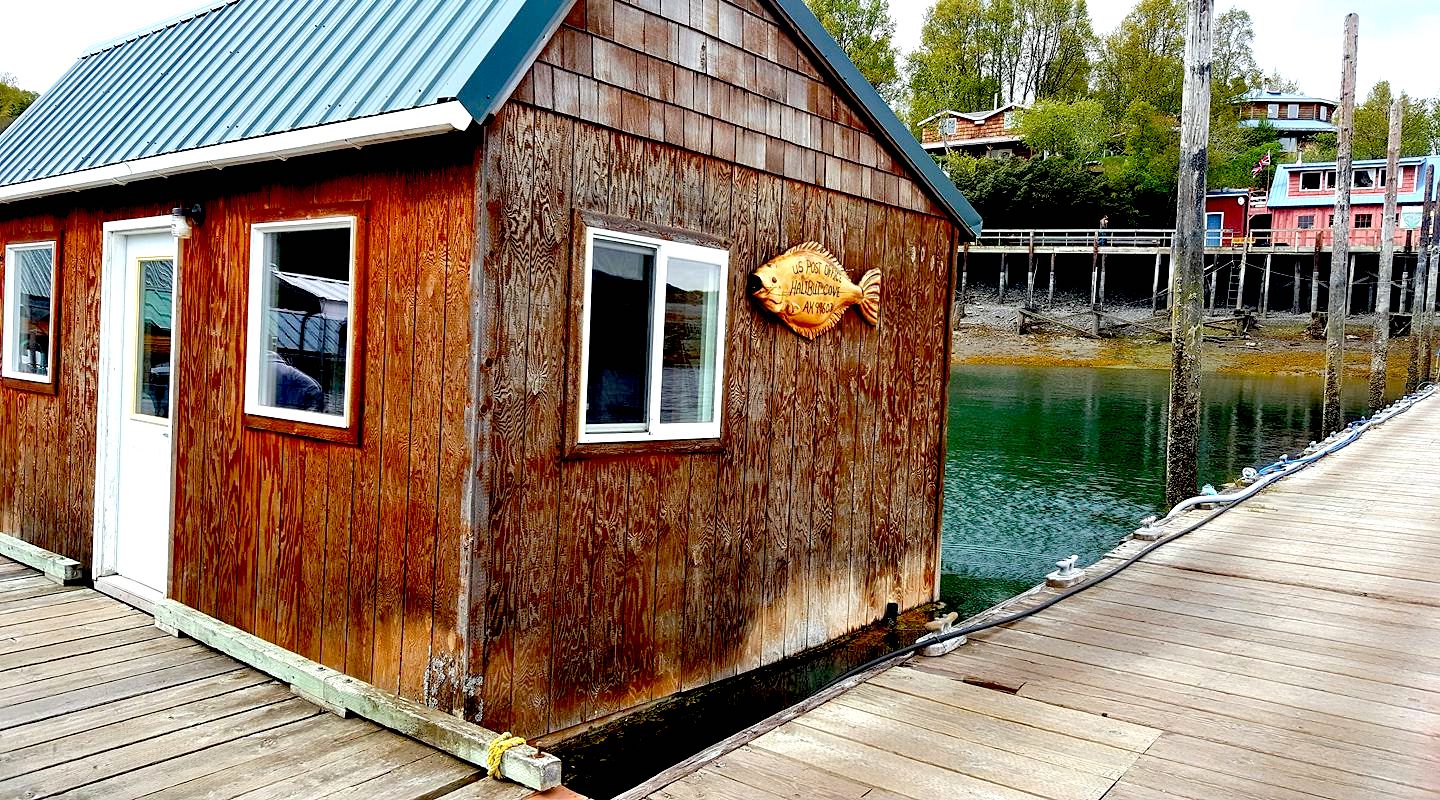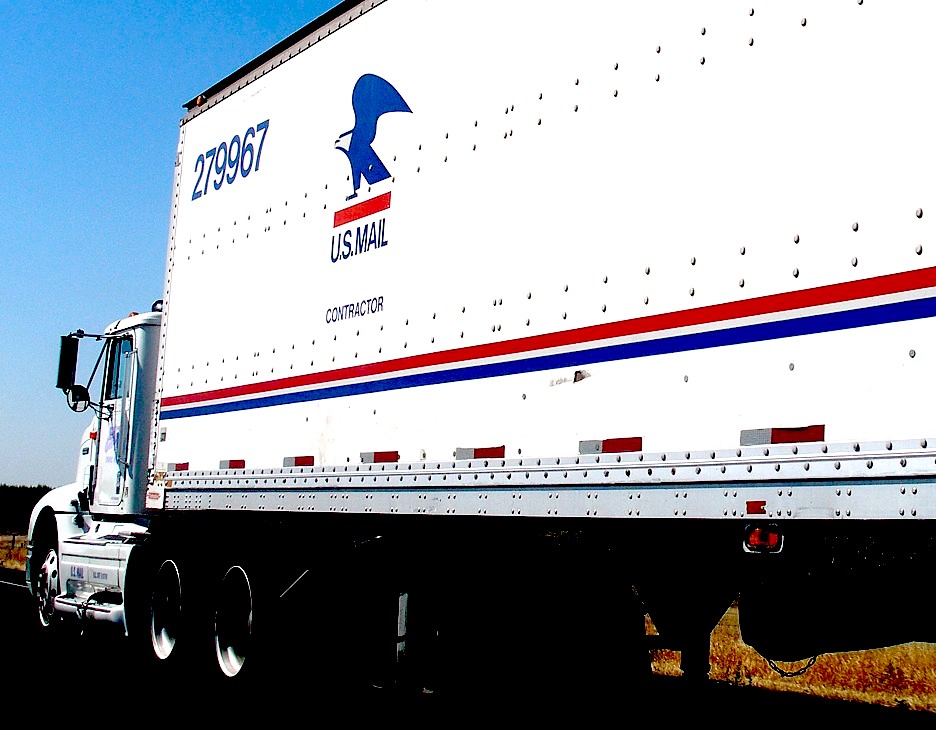Thousands of the jobs in the nation’s biggest unionized work force are at stake under Louis Dejoy’s modernization plan, which would slow down service for much of the country, writes Alexandra Bradbury.

U.S. Postal Service headquarters in Washington, D.C. (Tim1965, Wikimedia Commons, CC BY-SA 3.0)
By Alexandra Bradbury
Labor Notes
 Workers are battling an overhaul of the U.S. Postal Service that would cost thousands of jobs and slow the mail for half the country.
Workers are battling an overhaul of the U.S. Postal Service that would cost thousands of jobs and slow the mail for half the country.
In the name of efficiency, a letter mailed within Cheyenne, Wyoming, would travel to Denver and back. And if you miss a package, your local post office would no longer have it. It might be 45 minutes away.
In March, Buffalo, New York, became the first place to fend off the closure of its mail processing plant, in a team effort by Letter Carriers (NALC) Branch 3 and Postal Workers (APWU) Local 374.
The unions turned out 300 people to picket in front of the plant, and 700 to pack a public hearing, said Branch 3 President David Grosskopf. They deluged USPS with feedback in its online survey.
They lined up the support of their state reps and city council; they got neighboring town councils to pass resolutions too. They even got their U.S. senator to call the postmaster general personally — and it didn’t hurt that their senator was Majority Leader Chuck Schumer. Within a few weeks, the plant consolidation was canceled.
Per @USPS, there will be NO changes to the Processing and Distribution Center in Buffalo. Proposed consolidation with mail operations in #ROC is no longer on the table. @News_8 pic.twitter.com/o1g0A2JRv2
— Natalie Kucko (@NatalieKucko) March 29, 2024
Robotic Mega-Plants
Postal workers are the nation’s biggest union workforce — 585,000 strong, split across four unions. They’re half women, 30 percent Black and 16 percent veterans.
Thousands of their jobs are at stake under Postmaster General Louis Dejoy’s 10-year “Delivering for America” modernization plan, which would close 200 mail processing plants and funnel all mail to 60 mega-plants called Regional Processing and Distribution Centers (RPDCs), each with a football-field-sized parcel sorting machine — a series of conveyor belts, scanners and chutes that can sort 5,000 packages an hour.
USPS is chasing its competitors Amazon, UPS and FedEx, which already have bigger and more automated facilities like the UPS Worldport hub in Louisville, Kentucky, the size of 90 football fields, where a package touches human hands only twice — on its way in, and on its way out — traversing 13 minutes of conveyor belts in between.
We like heavy air freight. That is why in 2006 we opened the Worldport Freight Facility in Louisville, KY. #UPSLaunch pic.twitter.com/DDErXISsLJ
— UPS (@UPS) February 27, 2014
The Buffalo mail plant would have been downgraded to a Local Processing Center, handling only incoming letters and flat mail. APWU and National Postal Mail Handlers Union (NPMHU) members no longer needed in the pared-down plant wouldn’t technically be laid off, but “excessed”: Of course there’s still a job for you, 75 miles away at the new mega-plant in Rochester! That’s how USPS gets around contractual anti-layoff protections, knowing many workers won’t uproot their lives.
Wyoming has only two mail plants, and both are slated to be downgraded, so all the mail (and many of the jobs) will travel out of state to the nearest RPDC. It used to be that local mail could get there overnight, said mail handler Ricci Roberts, president of the Cheyenne branch of NPMHU Local 321.
Now it will take at least two days, but more likely three or four, she says, as letters travel to Denver and back. There will be no way to separate local mail, because her plant will lose its AFCS (Advanced Facer Canceller System) machine — the one that sorts raw letters, cancels the stamp, and adds the barcode, all at a speed of 36,000 items an hour. They’ll keep their DBCS (Delivery Bar Code Sorter) machine, which sorts incoming mail (at a similar clip) to get it ready for carriers to deliver.
The machines for sorting flats, such as magazines, are also being removed from plants around the country.
Disastrous Changes

DeJoy in 2020. (Daniel Afzal, U.S. Postal Service, Wikimedia Commons, Public domain)
The first regional processing centers have already opened, with disastrous results. Machines malfunctioned; the plants were seriously understaffed; the schedule was chaos; managers had no idea what they were doing. Mail piled up, and on-time delivery rates plummeted.
Local news outlets and congressional representatives sounded the alarm on mail delays. In Richmond, Virginia, colon-cancer screening tests for 870 veterans sat so long in the plant that they expired. A museum reported it was missing $300,000 in membership renewal checks.
In Atlanta, trucks waited three or four hours for their turn at jammed loading docks; the line got so long it backed up onto the highway. In Houston, an anonymous worker tipped off the press that the new sorting machine wouldn’t fit in the new building.
USPS says these are just growing pains. But it has had to slow down, faced with protests and congressional pressure. In May, DeJoy announced he would pause any further plant consolidations until the new year. In September, USPS canceled the downgrading of another eight plants besides Buffalo.
Public Treasure
Postal Service competitors are all in the package sector. There’s nobody else delivering birthday cards and pension checks — because this is a public service, not a money-maker.
True, you can send a document by UPS or FedEx, but it’s going to cost you dollars, not cents, and even more for a remote or rural address. Only USPS has a mandate to provide universal service at universal rates. Only USPS visits every doorstep, every day.
Demand for this service has declined in our era of email and electronic payments — but it’s still significant. Last year USPS carried 59 billion pieces of first-class mail, 3 billion periodicals and 7 billion packages. USPS is also still the biggest package shipper, though probably not for long. Last year Amazon leapfrogged UPS, and it is close on the Postal Service’s heels.
Muddying those figures is the fact that USPS actually completes the “last mile” of delivery for a substantial share of Amazon and UPS packages. Even as Amazon expands its subcontracted, nonunion delivery force, it’s likely to keep leaning on USPS wherever deliveries are too far-flung and labor-intensive to be profitable.
Competition from USPS also keeps a lid on the rates that UPS and FedEx can get away with.
Hubs & Spokes
Under DeJoy’s plan, some of the downgraded plants would also house Sorting and Delivery Centers (S&DCs), another new type of facility: home base for letter carriers from five to 10 zip codes.
Till now, letter carriers have always reported directly to the post office in their zip code. Many work at their own neighborhood post office, said Grosskopf, the NALC, Branch 3 president, where they enjoy the benefits of a short commute and know they can make it to work in any weather.
“You gotta remember, this is western New York,” he said. “We get this little thing called snow every now and then.”
There are 31,000 post offices in this country — one per zip code — more than there are Starbucks and McDonald’s locations put together. Think of post offices as a web: 99 percent of us have one within 10 miles of home. The new setup would be Amazon-style hubs and spokes.
Many carriers would commute 30-45 minutes to pick up the mail from an S&DC, then drive straight back to their delivery neighborhood in a rickety USPS delivery truck — and reverse those steps again at the end of the day.
Anti-Rural Discrimination

Floating post office, Halibut Cove, Alaska, 2018. (Beeblebrox, Wikimedia Commons, CC BY-SA 4.0)
Another prong of DeJoy’s plan, “Regional Transportation Optimization,” will eliminate end-of-day mail pickup from post offices farther than 50 miles from a regional processing center — which is three-quarters of all post offices, covering half the population — adding another day to delivery times.
“He wants to have full trucks only,” Roberts said. “From a rural lens, looking at it here in Wyoming, we never get full trucks. We don’t have the population to sustain that. So the only way to do that is to delay the mail.”
“It’s discrimination against the rural communities, without coming out and saying it.”
Piecemeal Privatization
What’s behind all the attacks on the postal service? Unlike other public services that are perennially on the chopping block, USPS already gets zero tax dollars.
Yet a string of right-wing politicians, President-elect Donald Trump among them, have called for privatizing it. Some European countries have actually done that, to the detriment of customers and workers. The U.K., for instance, privatized the Royal Mail a decade ago; now its parent company plans to resell it to a Czech billionaire.
So far the U.S. public seems unwilling to stomach wholesale postal privatization. But piecemeal privatization started long ago, and the low-hanging fruit have already been picked.
Eighty to 90 percent of letter mail is presorted by private companies, which get a hefty postage discount for taking away union postal work. USPS also contracts out a lot of trucking — some of it to DeJoy’s old company, XPO Logistics.

USPS contractor-driven semi-trailer truck seen near Mendota, Calif., 2006. (Coolcaesar, Wikimedia Commons, CC BY-SA 3.0)
Steve Hutkins, a retired English professor who runs the excellent blog savethepostoffice.com, sees USPS undergoing a “gradual process of corporatization,” so that it is run more with the values of a profit-making business rather than a public service.
Service cuts, he has observed, generally end up saving less money than anticipated. “Most things that save money involve cutting services,” he said. “There’s no magic to just being more efficient.” And when you slow down the mail, some dissatisfied customers go elsewhere—so you lose revenue, eating into any cost savings.
A Better Way
Interestingly, this summer DeJoy moved to eliminate some of the presorting discounts for package consolidators. Perhaps this simply makes business sense now that USPS can do the work more cheaply in-house, by replacing workers with machines.
Still, in a press release, APWU President Mark Dimondstein called it “a welcome early step in the right direction” to undo rampant outsourcing.
Postal unionists have their own vision for modernizing USPS: rather than cutting costs, raising revenue by expanding services. Since letter carriers are already visiting every door, why not offer an option where they check in on elderly residents?
Since post offices are already in every community, why not make them hubs for internet access, fishing licenses, passport renewals, electric vehicle charging, and even basic banking as an alternative to predatory check-cashing stands?
“If I were running the Postal Service, I wouldn’t want trying to save money to be my top consideration,” Hutkins said. “If the emphasis were on improving service rather than cutting costs, you could start talking about what else can the Postal Service do. Jobs are a good thing; they’re good for the community. I wouldn’t look to be replacing jobs with machines.”
Alexandra Bradbury is the editor of Labor Notes.
This article is from Labor Notes.
Views expressed in this article may or may not reflect those of Consortium News.

Ah yes, good old Joe Biden. He was not going to fire DeJoy, who was appointed by Trump.
I have signed quite a number of online petitions to fire DeJoy, but Biden and the USPS Board of Governors would not do it.
Obama and Biden would stand to gain from the privatization of the US Postal Service. Obama’s appointee’s company has business dealings with Dejoy’s logistics business. Biden, we know, is completely compromised by bribery. Neither Obama nor Biden asserted their power to help USPS during their time in office–a transgression of omission. So, one more reason why the Democrats lost the election. They had all this time to replace Dejoy, and now Trump–who named Dejoy to the position of Postmaster General-is back in the White House. Can we say how messed up that is? And how the Democrats through their own corruption and self-deling have given us this absolute betrayal of the working class, over and over?
That’s not quite fair. DeJoy inherited a 50/60 year old “Complicated” problem.
And to expect it to be fixed in just a few years is wrong thinking.
USPS has an extensive national advertising campaign. TV, etc. How much does that cost? It it effective? I doubt it.
I do not want to be advertised to by any agency of my own government.
According to my local carrier, their bread & butter is junk mail. With email, smart phones, electronic bills, and no “long distance”, personal letter # are down. I’ll bet Christmas card # are down as well.
The price to ship a package via USPS is outrageous now. I used to be an ebay power seller, then worked for a mini company where we shipped all product. USPS was traditionally cheaper for small packages, especially if going to remote addresses, because they charged the same close or far in the US. Competitors UPS and Fedex charge according to how far they must drive the package from one of their hubs. More accurate systems.
Still on topic, I wonder what the salary-benefit-pension package is for USPS workers. Today, government workers in general are compensated more than those in the private sector–an out of balance economy in my book.
The US Postal service has seriously declined. It is dying from neglect. This is the way leaders kill a public service and replace it with a private, profit driven, and expensive one.
Fascinating how this story ‘disappeared’ for four years.
DeJoy was of course appointed by Trump, and these plans began then. Biden and the Democrats kept the same leader and the same board in place, and the same plans continued. But now, like Magic, as soon as Trump wins the election, the stories about the USPS return to the left’s consciousness. This has been going on for the last four years. Everything in this article has been happening under the ‘most pro-union President.’
In fact, Consortium News published a piece on post office consolidation in 2021, during the Biden administration.
hxxps://consortiumnews.com/2021/10/01/us-mail-about-to-get-slower-more-expensive/
Yes